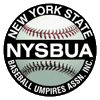1-3-1: The ball shall be a sphere formed by yarn wound around a small core of cork, rubber or similar material and covered with two strips of white horsehide or two strips of white cowhide tightly stitched together. It shall be 5 to 5 ¼ ounces in weight and have a circumference of 9 to 9 ¼ inches. The Coefficient of Restitution (COR) shall not exceed .555. The ball shall meet the NOCSAE standard at the time of manufacture and the mark is required on all balls. (Effective January 1, 2019) A minimum of three umpire-approved baseballs shall be provided to start the game. Unless otherwise mutually agreed upon, the home team has this responsibility. No less than two baseballs shall be used to complete the game.
The NFHS Authenticating Mark is required on all balls that will be used in high school competition. A current list of NFHS authenticated products can be found on the website: www.nfhs.org.
Rationale: To maintain a consistent and uniformed standard for high school baseball competition. To ensure that every baseball manufactured meets the same level of quality and playability. This proposal is recommended and endorsed by the NFHS Sports Medicine Advisory Committee (SMAC) to minimize risk.
1-3-2a2: Non-wood bats shall not have exposed rivets, pins, rough or sharp edges or any form of exterior fastener or attachment(s) that would present a potential hazard.
Rationale: Clarification to better delineate what cannot be attached on a bat.
1-5-3: The catcher shall wear, in addition to a head protector, a mask with a throat protector, body/chest protector that meets the NOCSAE standard at the time of manufacture (Effective January 1, 2020), protective cup (male only), and baseball protective shin guards.
Rationale: A NOCSAE standard has been developed to protect the heart and the cardiac silhouette from commotio cordis. The NOCSAE standard could be included in a product that is either a separate device/apparel or a device constructed into a traditional chest protector. This proposal is recommended and endorsed by the NFHS Sports Medicine Advisory Committee (SMAC) to minimize risk.
8-2-7: A batter-runner who reaches first base safely and then over-runs or over-slides may immediately return without liability of being put out provided he does not attempt or feint an advance to second.
Rationale: This is a simple change that is fair for all batters and is more umpire-friendly.
2018 Major Editorial Changes
NFHS Casebook: It has been recommended to amend the entire NFHS Casebook to reflect the nomenclature of how runners are identified in case situations. R1, R2, R3 will now represent the base that they (the runners) are occupying. In addition, the Batter-Runner will now be known as “BR” and the Batter will be identified as “B”.
Rationale: Moving to this new identification of base runners will assist in promoting and educating officials through various NFHS print and electronic mediums.
2018 Points of Emphasis
- Sportsmanship (National Anthem Stand-Offs, Bench Jockeying, Celebrations, Negative comments between opponents)
- Jewelry Rule Enforcement
- Proper Administration of NFHS Rules
- Proper Pitching Positions

